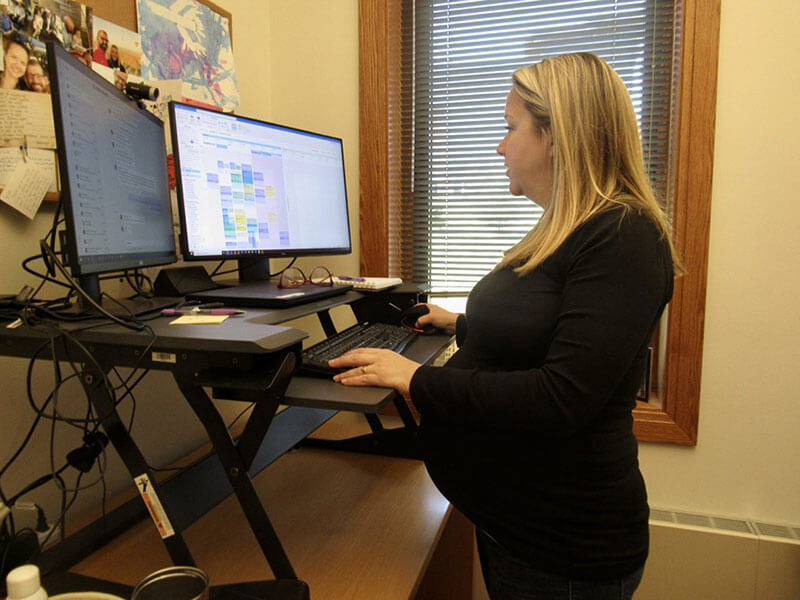Preparing for parenthood is an exciting time! From sharing the news, to all the onesies, car seats, strollers, and dozens of other things to buy, to all the general life adjustments to make, the logistics that come with preparing for a family addition can seem overwhelming. For all the working parents out there, appropriately planning for parental leave can help take the stress out of this transition.
Carex had the opportunity to ask Jackie Cook, Founder of Popins, about some of the biggest things to keep in mind when planning for parental leave (both as an employer and as an employee). Read on to learn about Popins and their mission and get 4 essential parental leave planning tips!
Jackie’s Story—Founding Popins
Before founding Popins one year ago, Jackie spent 15 years working in Healthcare IT, leading complex implementations and customer scenarios, and managing large teams to achieve great results.
Throughout her first pregnancy and maternity leave, Jackie was working in the Netherlands, where every woman has a right to postnatal care. She had to get her job ready for her to leave but didn’t think too much about her personal life. After her son was born, a postnatal caregiver came to their home for a few hours each day to check on Jackie’s physical and mental health, answer questions, assist with breastfeeding and bathing, and give the new parents confidence.
Jackie’s family is now located in Madison, WI. When her daughter was born here, the difference in postnatal support was immediately noticeable, as after delivery, U.S. healthcare focuses more on the baby than the mom or family as a whole. Her experience, along with countless stories from other new parents, inspired her to start her own company dedicated to helping families thrive.
 4 Essential Parental Leave Planning Tips
4 Essential Parental Leave Planning Tips
Some things about preparing for parental leave seem clear cut—review the company’s parental leave policy, get set up on FMLA, let coworkers know, etc. But for passionate, career-oriented expecting parents who want to honor their commitment to work and are nervous about how their coworkers will be taken care of while they’re gone, prepping may seem complicated. But it doesn’t have to be! Here are four tips from Jackie to ensure a smooth transition away from—and back to—work.
1. Evaluate your current role and ensure coverage.
The first thing most people think when planning parental leave is “Who’s going to handle all of this while I’m gone?” And yes, clearing your calendar and delegating tasks is crucial. But it’s also important take a minute to evaluate your responsibilities as they currently stand and make sure the right stuff is on the right person’s plate in the first place.
“Parental leave is an opportunity for both the business and the individual to step back and take a full look at what you’re doing in your role,” says Jackie. “Is this stuff I should be doing, and want to do, when I come back? Look at all the day-to-day things, and reevaluate based on skills, bandwidth, and passion.”
In Jackie’s own experience, going on parental leave provided an opportunity to help grow the team around her. Before leaving, she handled 100 clients, which were all handed off to her team members in her absence. Upon returning, she only took back the biggest 5 of those original clients, and she was able to reevaluate the company’s relationships with those customers and give old projects fresh life.
Not only did her team prove they could take great care of those clients during her leave—Jackie was able to expand her skills and explore new pursuits upon her return!
2. Set clear expectations.
Under FMLA regulations, the person on leave shouldn’t be working (some companies shut off their access completely!), so clear expectations set ahead of leave will allow both employers and new parents to rest easy.
For employees, this means clearing your calendar and making sure no one is expecting anything of you, delegating ongoing tasks and ensuring the team knows who to contact for those tasks, and establishing an expectation of who can call if something comes up (usually a direct supervisor).
For managers, Jackie recommends having a conversation three to four weeks before the due date, to ask “When, or in what cases, do you want me to get a hold of you?”
New parents should also set a meeting two weeks before they are set to return to touch base with their manager about how things are going—are you still coming back on that day? Is there anything you need?
 3. Keep lines of communication open after you return to work.
3. Keep lines of communication open after you return to work.
It’s often months before babies sleep through the night, and many parents return to work before decent sleep is a reality at home. Returning breastfeeding moms will also need to breastfeed or pump, usually 2-3 times during a typical workday. Some parents will be excited for a return to normalcy and to jump right back into work, while others might find themselves struggling to get back in routine. The best question for managers to ask returning parents: “How are you doing, and what do you need?” This conversation should continue week to week, as needs will change as parents settle back into work.
“There’s a wide spectrum of how parents are treated when they return to work,” says Jackie. “Some people feel tiptoed-around and overly accommodated for, or even isolated, while others find themselves receiving the same treatment as before, with not enough accommodations.”
Two examples of good-intentioned acts on opposite ends of the spectrum that can be easily misinterpreted are:
- Treating a new parent exactly the same way as before baby, with little support or accommodations (“Thank god you’re back—here’s all your work again!”)
- Setting meeting times under the assumption that new parent will be dealing with baby at certain times, or just not inviting them to the meeting at all even though the subject matter pertains to them (“I didn’t want to bother you—you have a newborn!”)
As a best practice, Jackie recommends new parents work with their managers to ease back into work, and that companies support a ramp. “Build a ramp—don’t just go from 0 to 100. And this ramp will look different based on the role and individual. Start back on a Thursday instead of Monday. Go back part time for a week. Have conversations with your supervisor and set priorities—ask ‘What happened while I was gone? Are there things that don’t need to be taken back, or need to be shifted?’”
 4. Stack your support team.
4. Stack your support team.
The thing Jackie’s most passionate about is planning to stack your support team for those first few weeks after your baby arrives. “Between your professional and personal support network, stack the odds in your favor. Every hour you have someone else checking in on your mental health, cleaning your kitchen, helping you breastfeed, is another hour you have to help you focus on your new baby—your new role. It’s a fleeting time, so planning for that support in advance is crucial. You won’t have to worry about it—just hold your baby.”
 Whether you’re a parent-to-be, family member of expecting parents, or an employer looking to learn how to better support employees going on leave, you should check out all the services Popins has to offer at popinsfam.com!
Whether you’re a parent-to-be, family member of expecting parents, or an employer looking to learn how to better support employees going on leave, you should check out all the services Popins has to offer at popinsfam.com!
